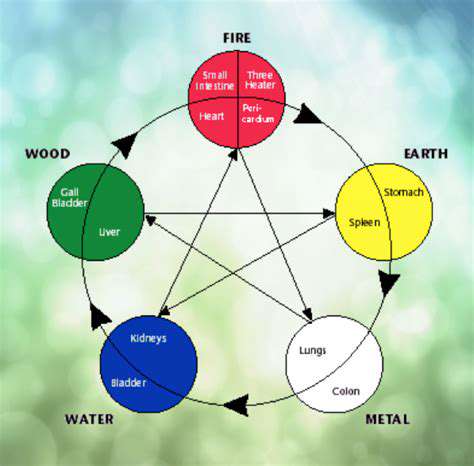Designing a garden that promotes harmony and growth
Understanding the Site
Every great garden begins with a deep connection to its environment. Truly knowing your space goes beyond surface-level observations—it demands attention to subtle details like wind patterns, soil quirks, and sunlight dances. I've watched many gardeners fail by planting before understanding how morning fog lingers in their south corner or why certain patches stay soggy after rains. The land speaks if we listen carefully.
Take time to notice where water pools after storms and which areas dry fastest. Track how shadows move across your space throughout seasons. These observations become your gardening compass, guiding plant choices that'll thrive rather than struggle. Remember, a plant's success depends more on matching its natural habitat than our aesthetic wishes.
Choosing the Right Plants
Plant selection resembles composing a symphony—each species plays a unique role in the garden's harmony. I've learned through experience that combining plants with complementary needs creates effortless beauty. A rosemary's woody structure plays beautifully against lamb's ear's velvety leaves, while their shared drought-tolerance makes care simple.
The secret lies in creating plant communities rather than isolated specimens. Group thirstier plants near your rain barrel, place sun-worshippers where light lingers longest, and let shade-lovers nestle beneath tree canopies. This thoughtful arrangement mimics nature's wisdom, reducing work while increasing vitality.
Designing for Flow and Balance
Great gardens move visitors emotionally as much as physically. I design pathways to unfold views gradually, placing bold textures up close and softer hues in the distance to create depth. A well-placed bench or striking specimen tree acts as punctuation in the garden's visual story.
Remember to design for all seasons—spring bulbs giving way to summer perennials, autumn grasses catching low light, winter evergreens providing structure. This temporal rhythm keeps gardens alive in our memories year-round.
Maintaining Harmony Through Time
Gardens breathe and change like living beings. My approach embraces this evolution—pruning becomes shaping conversations rather than control. I leave some seedheads for winter birds and let certain plants self-sow where they choose. This flexibility creates resilient ecosystems.
Weekly walks with a notebook help me spot subtle changes before they become problems. Observation is the gardener's most powerful tool, revealing when plants need dividing, where mulch has thinned, or which combinations no longer sing together.
Choosing Plants for a Balanced Ecosystem

Factors to Consider When Selecting Plants
Building a thriving garden ecosystem starts with understanding nature's interconnected web. I always consider how each plant contributes beyond its beauty—does it feed pollinators? Shelter beneficial insects? Improve soil health? True sustainability means seeing plants as community members rather than decorations.
Native Plant Selection
After years of trial, I've found native plants offer unmatched resilience. My purple coneflowers withstand droughts that wither exotic imports, while supporting twice as many pollinator species. Native plants represent generations of evolutionary wisdom we'd be foolish to ignore.
Start small—replace a lawn section with native grasses or add a cluster of milkweed. You'll be amazed how quickly wildlife responds to these familiar hosts.
Sunlight Requirements
Light conditions often vary dramatically within small spaces. I map my garden's sun patterns monthly, noting how tree canopies and structures create shifting mosaics. This helps match plants to their ideal conditions—ferns for persistent shade pockets, lavender for baking south slopes.
Water Needs
Water-wise gardening begins with honest assessment. In my Mediterranean climate, I've embraced dry-adapted plants that flourish with minimal irrigation. Grouping plants by water needs creates efficient zones—thirsty vegetables near the hose, drought-tolerant salvias in far corners.
Smart water use isn't about deprivation but working with natural patterns. My rain garden captures runoff, while swales direct moisture to where it's needed most.
Soil Composition
Rather than fighting my clay soil, I've learned to improve it gradually with compost while choosing plants adapted to its nature. Serviceberries and switchgrass thrive where delicate roses struggle. Good gardening means building from existing conditions rather than imposing unrealistic ideals.
Pest and Disease Resistance
Healthy plants resist pests naturally. I prioritize disease-resistant varieties and encourage beneficial insects by providing diverse habitats. A few aphids become ladybug food rather than crises needing sprays. This balanced approach creates self-regulating systems.
Biodiversity and Ecosystem Support
My garden's greatest joy comes from its thriving food web—bees working blossoms, birds nesting in shrubs, toads sheltering under leaves. This vitality springs from planting layers that mimic natural ecosystems—tall canopy trees, understory shrubs, herbaceous plants, and groundcovers each hosting different life.
Maintaining Harmony Through Regular Care and Observation

Establishing a Routine
Successful gardens thrive on consistent attention rather than heroic interventions. My morning coffee walks let me spot wilted plants needing water or pests before they explode. Small, regular care prevents overwhelming chores later.
Prioritizing Communication
Gardens communicate constantly—yellowing leaves signal nutrient needs, stunted growth suggests poor conditions. Learning this language transforms maintenance from work to rewarding dialogue. The best gardeners develop deep listening skills.
Respecting Boundaries
Plants need space as much as people do. I've learned to resist overcrowding, giving each specimen room to breathe. Proper spacing prevents disease and lets each plant shine. Generous spacing is a gift that pays dividends in plant health.
Cultivating Empathy
Great gardening requires understanding each plant's nature rather than forcing our will. My Japanese maple will never be a towering shade tree, but makes perfect dappled light for hostas below. Working with a plant's true nature creates effortless beauty.
Finding Common Ground
The most successful plant combinations share cultural needs while offering contrasting forms. My sunny border pairs drought-tolerant yarrows and sedums—different textures united by similar requirements. These harmonious groupings please both plants and viewers.











